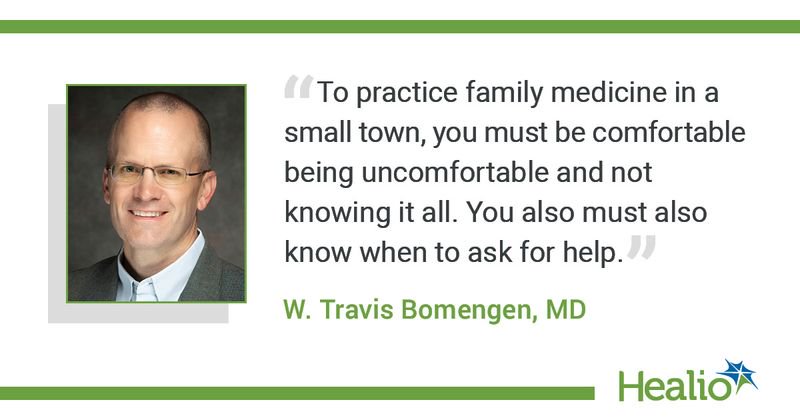Q&A: Wyoming program trains PCPs for careers in rural practice
Americans who live in rural areas are disproportionately affected by poor health outcomes, data suggest.
According to a report from the CDC, the overall, all-cause, age-adjusted mortality rate in the United States in 2014 was 724.6 per 100,000 people. In rural areas, that rate was 830.5 per 100,000 people while in urban areas, the rate was 704.3 per 100,000.

In addition, the National Rural Health Association estimates that the patient-to-primary care physician ratio in rural areas is 39.8 physicians per 100,000 people compared with 53.3 physicians per 100,000 in urban areas.
To help close the rural health care gap, the U.S. Health Resources and Services Administration recently awarded $2.1 million to the University of Wyoming (UW). According to a UW press release, the grant will help fund a rural training track in Thermopolis, Wyoming, that aims to prepare PCPs for practicing medicine in rural communities throughout the state.
Healio Primary Care spoke with W. Travis Bomengen, MD, a family physician at Red Rock Family Practice in Thermopolis and site director and associate medical program director of the new rural training track, about the goals of the program, health care challenges that rural physicians face and more.
Q: What do you hope the program accomplishes?
A: We want to recruit and train medical residents specializing in family medicine to provide a full spectrum of family medicine in rural America. Some of these residents think their career will be focused on treating patients in the clinic and performing hospital medicine. Our program seeks to change that mindset by training residents about the full spectrum of medical care that is needed in a rural community. To practice family medicine in a small town, you must be comfortable being uncomfortable and not knowing it all. You must also know when to ask for help.
We provide a longitudinal curriculum that provides students training in pediatrics, obstetrics, geriatrics and more all in 1 day. The residents conduct hospital rounds, deliver a baby, see patients at the clinic and then visit patients at nursing homes — all in the course of a day or 2 — for a more real-life experience that also gives them the confidence that they can provide that level of care throughout their career.
Q: What challenges are unique to providers in rural communities?
A: Unlike some physicians in urban areas, we wear many different hats. We work in the emergency room, car for patients in the hospital, we see patients in the nursing home, we provide care in the outpatient clinic, we do home visits and oftentimes we provide curbside medicine at the convenience store while we fill our cars up with gas. We also serve as leaders of different community organizations.
While we have MRIs, CT scans and many other modern medical technologies, rural areas often lack the interventions that neurosurgeons, cardiologists and other types of specialists can provide. For example, if a patient is having a heart attack, my goal is to provide that patient a thrombolytic drug within 30 minutes. However, in large urban tertiary centers, the goal may be to provide a procedural intervention with an angioplasty or stent.
Q: How do PCPs in rural areas work around that lack of specialty care?
A: We maintain a good relationship with our tertiary care hospitals. The closest one in Casper, Wyoming, is about 2 hours away and there is another in Billings, Montana, which is about 3.5 hours away. Many of those centers’ specialists will conduct outpatient clinics, perform phone consults and help via telemedicine to help us treat challenging cases.
Q: What are the benefits of being a PCP in a rural community?
A: One of the biggest benefits is the lifestyle. When I am not working, I love hunting, fishing and hiking in the mountains. These activities are 5 minutes from my door.
Another benefit is the variety of medical care that I spoke about earlier, the never knowing who you may see and what condition you will take care of or diagnose during the course of the workday. As my career has progressed, , I have built long-standing, solid professional relationships with my patients and family units, watching the children that I delivered grow up and walk across the graduation stage and helping some of my older patients navigate the end of life process with grace and dignity. However, this benefit of knowing your patients so well can lead to a challenge: when you see a friend whom you have care for many years dying in front of you, that can be emotionally challenging.
Editor’s note: This article is part of an ongoing series spotlighting people and institutions who are making innovations in primary care. If you or your institution are taking important steps to improve the quality and cost of care in the primary care setting, please email us at primarycare@e.healio.com .
References:
- Garcia MC, et al. Morb Mortal Wkly Rep. 2017;doi:10.15585/mmwr.ss6602a1.
- Health Resources & Services Administration. About National Rural Health Association. https://www.hrsa.gov/library/national-rural-health-association. Accessed July 10, 2020.
- National Rural Health Association. About rural health care. https://www.ruralhealthweb.org/about-nrha/about-rural-health-care. Accessed July 10, 2020.
